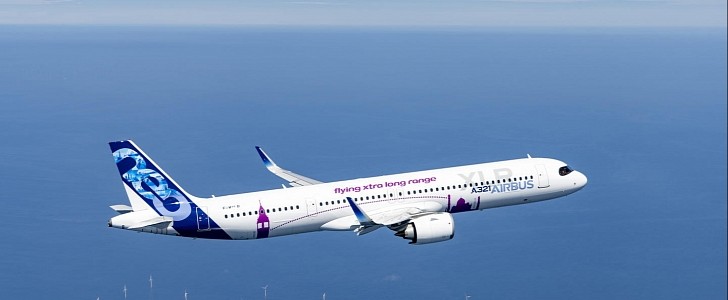While the environmental impact is presented as the most important factor influencing the development of future airliners, extending the range without compromising passenger comfort is another major goal. Airbus is on its way to deliver the highly-anticipated A321XLR in two years from now.
Airbus started assembling the first A321XLR prototype in 2021. Earlier this year, it successfully conducted its maiden flight, in Hamburg. Two more aircraft are almost completed and will soon join it. The fourth and final flight-test aircraft is actually a regular A321neo that’s been upgraded with the XLR’ s feature. Once all of them have started flying, Airbus will kick off the global flight testing campaign.
This is all part of the certification process, aiming to deliver the first extra-long-range aircraft in 2024. The next-generation A321XLR is expected to open new routes, such as India-Europe or China-Australia, thanks to its 4,700 nautical-mile (5,408 miles/8,704 km) range. And it will do so while burning 30% less fuel per seat, compared to the previous generation aircraft.
The A321XLR is based on the A321 that was designed back in the ‘90s, and it required certain modifications that would enable its long range. The main thing is an increased fuel capacity, which is why it was fitted with a permanent Rear Center Tank (RCT) that can hold more fuel, while taking less space. But this increased capacity also implies several other changes to the landing gear, braking systems, and cabin design.
All of these changes required complex testing. The first two prototypes will focus on the technical systems, flight controls, and handling, while the third one will focus on the thermal comfort and noise levels inside the cabin. Also, for the first time in its history, Airbus is certifying two engine types at the same time, instead of one after the other. To do that, the first prototype was fitted with CFM LEAP-1As engines, while the second one is powered by P&W GTF engines.
This complex testing campaign is still at the beginning, but it’s paving the way for an airliner that promises to be revolutionary.
This is all part of the certification process, aiming to deliver the first extra-long-range aircraft in 2024. The next-generation A321XLR is expected to open new routes, such as India-Europe or China-Australia, thanks to its 4,700 nautical-mile (5,408 miles/8,704 km) range. And it will do so while burning 30% less fuel per seat, compared to the previous generation aircraft.
The A321XLR is based on the A321 that was designed back in the ‘90s, and it required certain modifications that would enable its long range. The main thing is an increased fuel capacity, which is why it was fitted with a permanent Rear Center Tank (RCT) that can hold more fuel, while taking less space. But this increased capacity also implies several other changes to the landing gear, braking systems, and cabin design.
All of these changes required complex testing. The first two prototypes will focus on the technical systems, flight controls, and handling, while the third one will focus on the thermal comfort and noise levels inside the cabin. Also, for the first time in its history, Airbus is certifying two engine types at the same time, instead of one after the other. To do that, the first prototype was fitted with CFM LEAP-1As engines, while the second one is powered by P&W GTF engines.
This complex testing campaign is still at the beginning, but it’s paving the way for an airliner that promises to be revolutionary.







